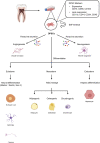Clinical Potential of Dental Pulp Stem Cells in Pulp Regeneration: Current Endodontic Progress and Future Perspectives
- PMID: 35478967
- PMCID: PMC9035692
- DOI: 10.3389/fcell.2022.857066
Clinical Potential of Dental Pulp Stem Cells in Pulp Regeneration: Current Endodontic Progress and Future Perspectives
Abstract
Dental caries is a common disease that not only destroys the rigid structure of the teeth but also causes pulp necrosis in severe cases. Once pulp necrosis has occurred, the most common treatment is to remove the damaged pulp tissue, leading to a loss of tooth vitality and increased tooth fragility. Dental pulp stem cells (DPSCs) isolated from pulp tissue exhibit mesenchymal stem cell-like characteristics and are considered ideal candidates for regenerating damaged dental pulp tissue owing to their multipotency, high proliferation rate, and viability after cryopreservation. Importantly, DPSCs do not elicit an allogeneic immune response because they are non-immunogenic and exhibit potent immunosuppressive properties. Here, we provide an up-to-date review of the clinical applicability and potential of DPSCs, as well as emerging trends in the regeneration of damaged pulp tissue. In addition, we suggest the possibility of using DPSCs as a resource for allogeneic transplantation and provide a perspective for their clinical application in pulp regeneration.
Keywords: allogeneic transplantation; dental pulp regeneration; dental pulp stem cells; immunomodulation; mesenchymal stem cells; regeneration medicine.
Copyright © 2022 Kwack and Lee.
Conflict of interest statement
The authors declare that the research was conducted in the absence of any commercial or financial relationships that could be construed as a potential conflict of interest.
Figures





References
Publication types
LinkOut - more resources
Full Text Sources

